Today was the third round of the telegram chess tourney. Since I had won both previous games, I was matched up with RonaldPatzer14, who has also won both games. The tournament has five rounds, and is structured in such a way that you play someone with the same score as you in each round. If you win all five games, then you will be crowned the winner.
Because the stakes are being raised here, as well as the quality of opponent, I decided to do a light amount of opponent preparation the night before our game was originally scheduled. I looked through my opponents previous two games, and then clicked on all the games that he had lost on Lichess with the White pieces, since I had Black for this game. I say originally scheduled, because there was some last minute rescheduling of the game to Monday morning.
Anyway, I didn’t find anything that was all that useful, with the exception of noticing that my opponent really liked capturing the pawn in Queen’s gambit declined type positions. Armed with that knowledge, I played the Slav defense, knowing that he would probably take my c6 pawn, giving us an equal position. Even if he didn’t, the Slav defense is totally fine anyway, and I have played it on occasion, so I wasn’t totally unfamiliar with the ideas there.
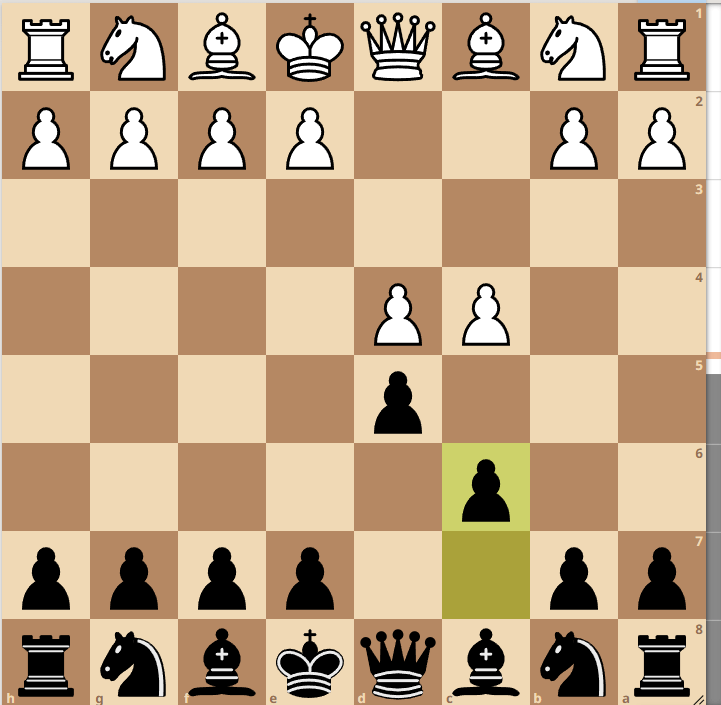
Before we go any further, you can find the game here. And wouldn’t you know it, my opponent did indeed take in the above position. After some more normal moves, I had a very comfortable position with Black. The computer even says that I have the slightest of advantages. That is, until I played what the computer says is my only mistake of the game with 10. e5?
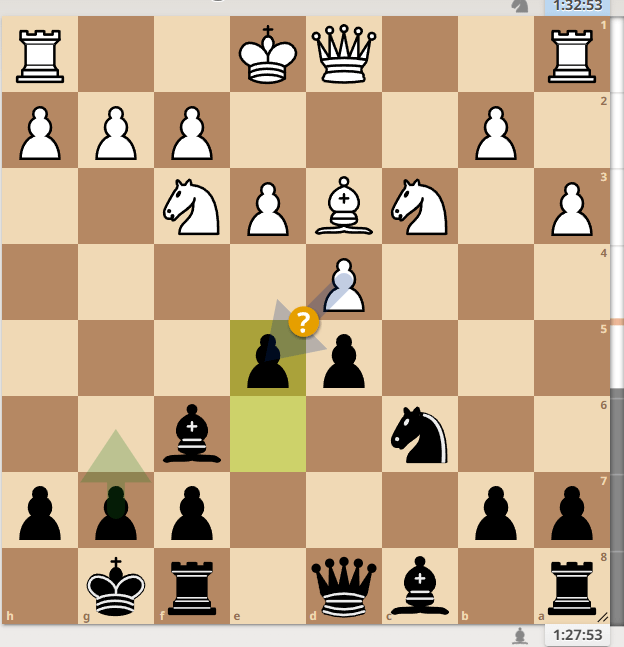
I thought my position was better than it was. Furthermore, the loss of material happens fairly deep into the line. I was preoccupied making sure that lines where he takes on e5, and then takes the pawn on d5 with his knight – exploiting the bishop check with Bxh7 which would win my queen if I recaptured – work for me. I had seen that, instead of capturing the knight, I can play Bxb2, and still have a decent position at the very worst, although we won’t go into all the lines. Considering that e5 frees my bishop, I was happy to play the move.
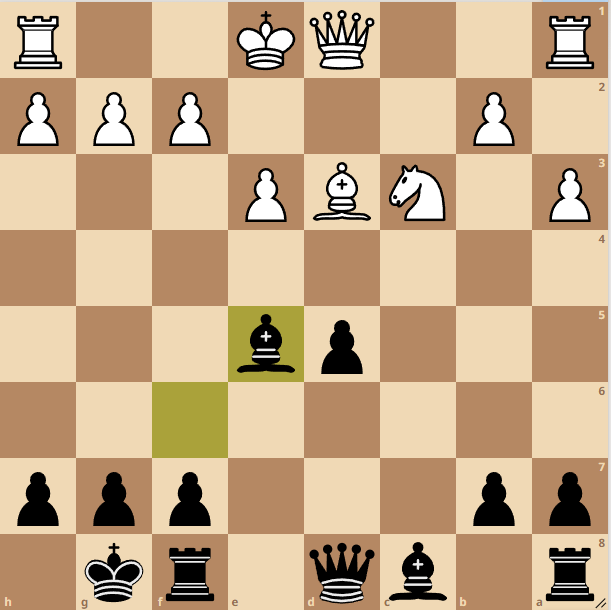
Unfortunately, just after I played e5 I realized that it was losing material after the simple captures on e5, in a way unrelated to the knight capturing on d5. I sat there shaking my head, so disgusted with myself for overlooking a simple tactic that I considered resigning the game. The move my opponent should play in this position is actually even better than the computer thinks that it is, because I needed to find a very tough to find defense in order to be only on the cusp of losing, The move I would actually have played would have left me down two pawns, with an exposed king and poor development.
My opponent, who had built up two minutes extra time on the clock, started using his time to calculate his next move, and I felt utterly doomed. Only to see RonaldPatzer14 play Qh5?!
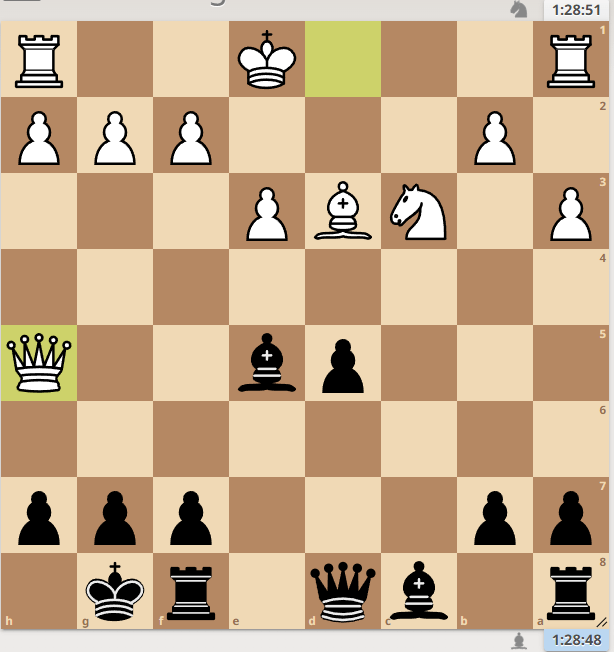
I was thrilled to see this move, because I can now take the knight on c3 with check, damaging White’s pawn structure, and then play g6 or h6, stopping the mate. Having escaped near certain death, I resolved to start taking my time more, and really own my moves.
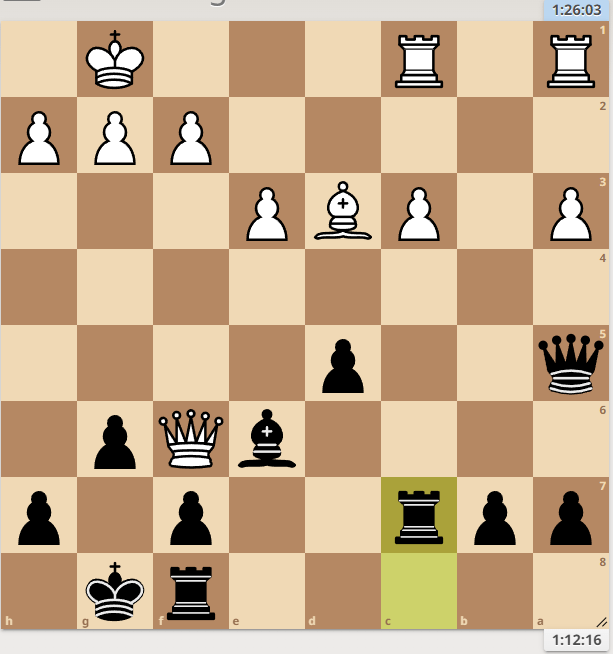
Despite this, I felt that I had totally thrown the game away just five moves later. I had been calculating between Rc7, and Rc6. They both have their advantages. However, I had made the classic mistake of focusing on my ideas instead of my opponents. I dismissed his counterplay with h4, only until playing Rc7. After the move was locked in I again got a sinking feeling in my stomach, sure that after h4 I was losing.
This was in part because I had dismissed h4, thinking that I could play h5. That move is a terrible blunder, since he can play Bxg6, and after fxg6, he at least has Qxe6, and he can probably play Qxg6+ first, winning two pawns in front of my king. Since h5 is out of the question, I began to panic somewhat, especially because the rook on c7, as opposed to c6, prevents me from playing Qc8, a move that I could play after h4, which could be useful in forcing the queen trade, or reinforcing f6, since if Rc6, h4, Qd8, Qf4, saving the queen, he’s not threatening mate with Qg7#, and he’s also not threatening the bishop.
And it’s the combination of the queen and pawn mate and the bishop sacrifice that makes the position so deadly. The computer says that I am actually fine, but not after the move I was planning to play after h4. Had he played that, there’s a good chance that I would have played Rc6, which is a sad move that gives away my advantage, and leaves White with a comfortable advantage instead.
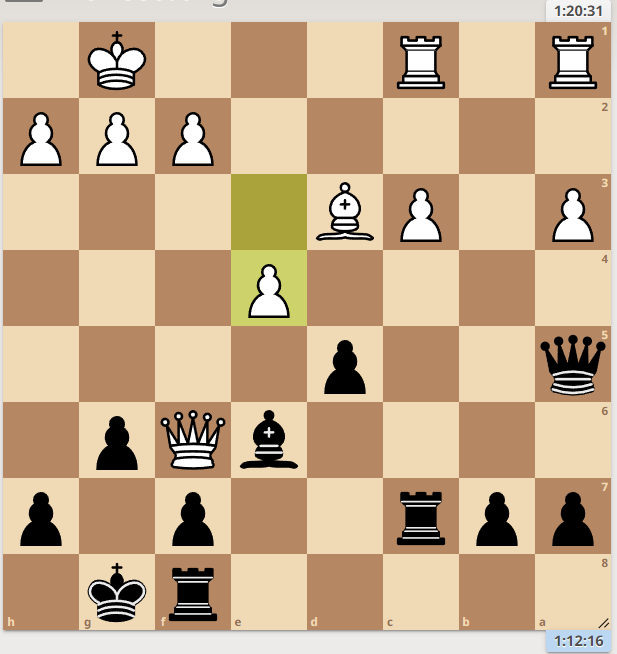
Instead my opponent played 19. e4, a mediocre move. After thinking for almost fifteen minutes, I ignored this, and swung my f8 rook over to c8. I had calculated a lot of nice lines, and was certain that I had a big advantage in all of them, soon to be up a pawn due to the indefensible pawn on c3.
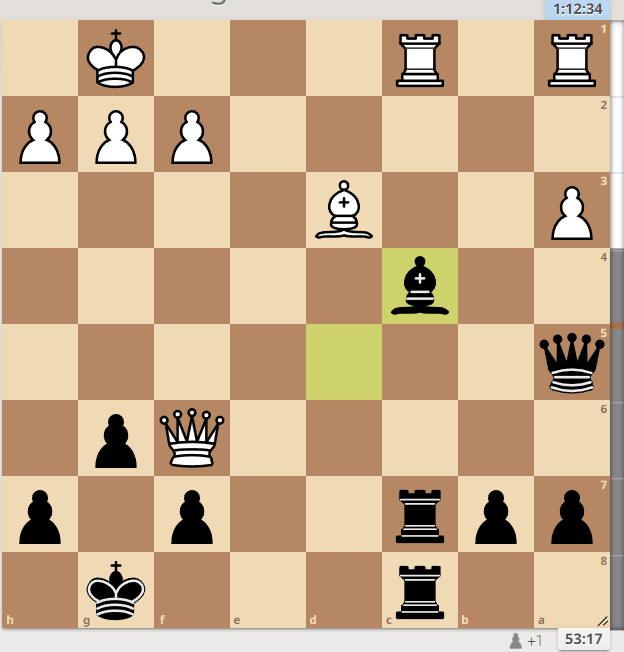 My opponent decided to push his doomed pawn to c4. I captured with the bishop, and calculated a very cute line if he had played Be4. I simply drop the bishop back to d5, and he cannot take immediately, due to the back rank mate. Even if he takes the rook, Qxc7 threatens the queen sac back rank mate, so he loses material. However, the engine finds a way to win his material back, exposing my own back rank issues, with the impressive Rd1, sacrificing the bishop, because after Bxe4, Rd8+, Rxd8, Qxd8+, Kg7 (all of this is forced after the capture) Qd4+, f6, he wins back the bishop with Qxe4.
My opponent decided to push his doomed pawn to c4. I captured with the bishop, and calculated a very cute line if he had played Be4. I simply drop the bishop back to d5, and he cannot take immediately, due to the back rank mate. Even if he takes the rook, Qxc7 threatens the queen sac back rank mate, so he loses material. However, the engine finds a way to win his material back, exposing my own back rank issues, with the impressive Rd1, sacrificing the bishop, because after Bxe4, Rd8+, Rxd8, Qxd8+, Kg7 (all of this is forced after the capture) Qd4+, f6, he wins back the bishop with Qxe4.

Sideline
It looks like he doesn’t have time to do that, because of back rank mate, but he can just drop his queen back with Qd1 after Qc1+. However, I would still be up a pawn with a winning endgame. Sometimes your position is too good to spoil.
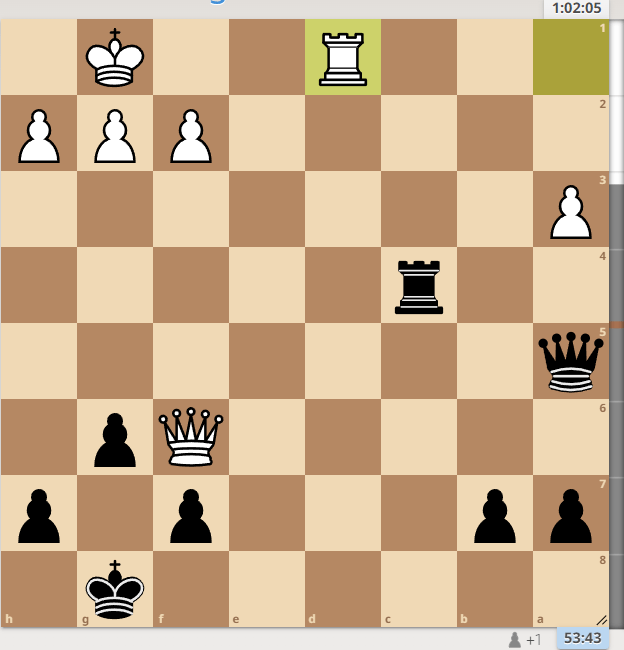
Anyway, my opponent didn’t do that, instead exchanging everything on c4, and then sliding the rook over to d1. There is definitely some danger in this position. For example, if Qxa3, Rd8#. If Ra4, then Rd8+ forces me to give up my queen. If I play h5 to give my king some squares, Rd8+ again loses the queen, because Rd8+, Kh7, Rh8#.
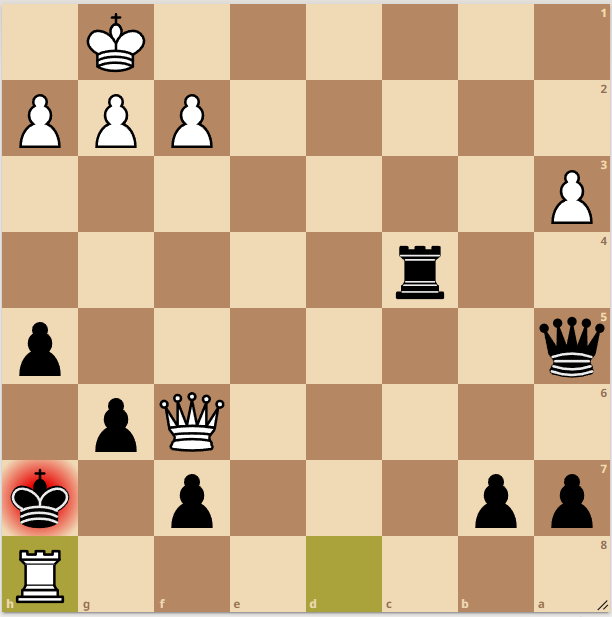
Sideline
The mates are fairly easy to spot, but White is also threatening some perpetual checks because his queen controls the a1-h8 diagonal. I can always retreat the rook to c8, but that kills a lot of my pressure on his position. Instead, I found a truly gorgeous move, and worked through all the variations. In the below position, can you spot the best move for Black?

Take a minute and really think about it.
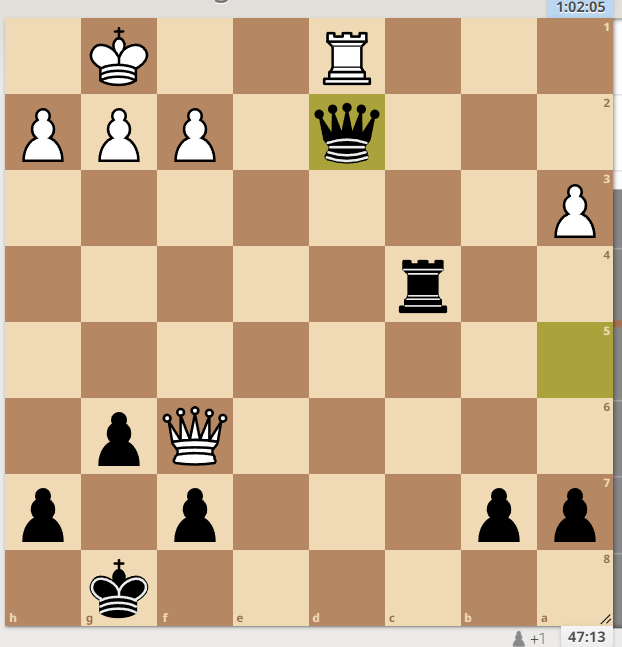
Qd2! The kind of move that needs to have every variation triple checked before playing. Rxd2 is the most obvious, and leads to back rank mate with Rc1+, Rd2, Rxd2#. Instead, White has three plausible moves, Qf3, Qd8+, and Qa1. Initially I felt that Qf3 ruins this line, and White is winning. Then I saw the move that makes Qf3 flat out does not work, can you spot it?
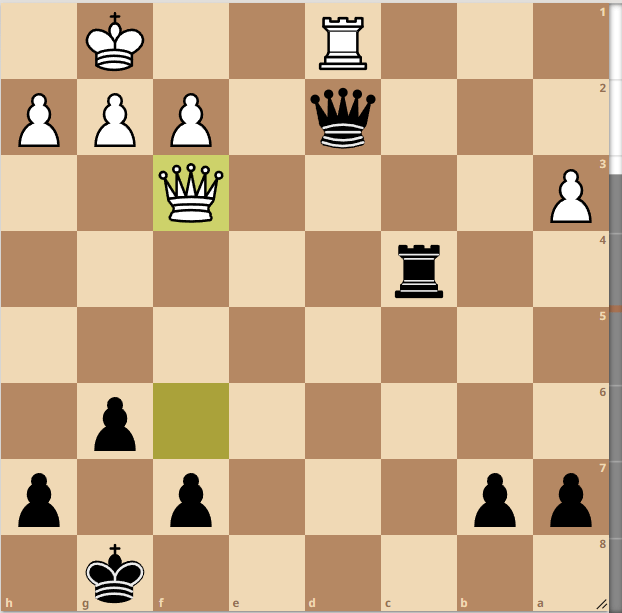
Rc1!
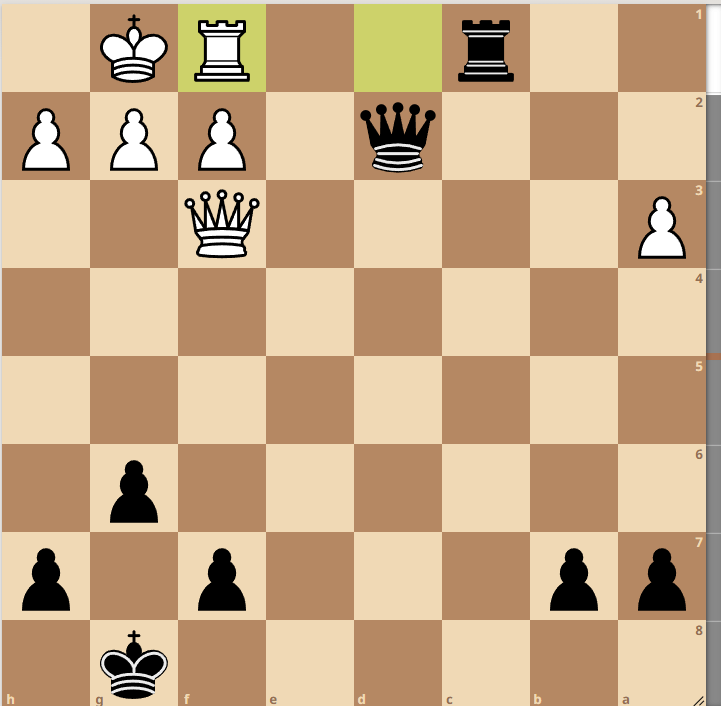
The rook is lost except for Rf1, and then we can play Qe1! What a ****ing move.

Sideline, but what a sideline indeed.
Although I was so focused on calculating his checks, that I didn’t see that White can actually play Qd3 in the above position. It’s still clearly a winning endgame after everything is traded off, it’s just not quite as nice as forced checkmate or immediate material win, which I thought it was. Again, my queen or rook can never be captured because of back rank mate.
Had he allowed it, Qd2! followed by Rc1! followed by Qe1! would probably have been the best combination I have ever played. Sadly, I didn’t get to play it, as my opponent played Qa1. If he had played Qd8+ that also wouldn’t be good, because the backrank issues force his rook to go back to the eighth rank. If he pushes a pawn in front of his king, then he lets my rook get to a4, and after I play b6, I felt that I have an fairly easily winning endgame.

Sideline after Qd8+. He must deal with back rank mate, giving me time to play Ra4, easily winning.
However, he played Qa8, which allows me to play Qc3. Again, part of what made Qd2 so sexy, is that it is an extreme tactic that, in this line, is used for nothing else than to trade queens without getting back rank mated myself (with the queen covering g7) with the calm Qc3. If he checks me now with the rook, I just step up with the king, and he has to retreat his rook or trade queens. He can’t even go after my pawn on b7 after the queen exchange, again because of back rank issues. If he tries playing Qb1, then I have Qc2, although the computer says this is an inaccuracy, and I should instead play b6 immediately, but it still leads to a winning endgame. To play an extreme tactic is one thing, but to play it for positional compensation in the best line? I felt like a goddamn grandmaster.
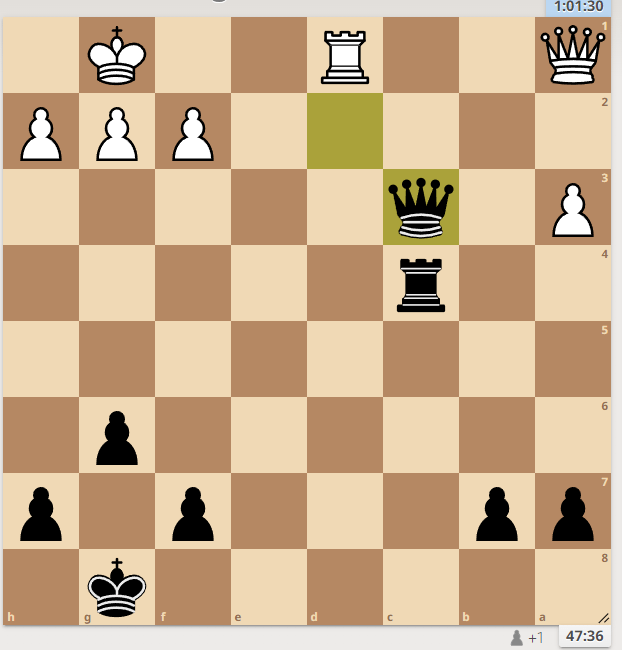
RonaldPatzer brought his king out, we exchanged queens, and I started pushing the soon to be passed pawns. On move 31 my opponent resigned. Even though he can win the pawn on b4 with Rxa3, bxa3, Kb3, my outside passed pawn makes this a trivial win. I can gobble up all his kingside pawns while he wastes time winning my outside passed pawn.

All in all, I am extraordinarily proud of this game, blunders aside. And I say blunders plural, because I consider myself to have made two of them in this game. The first the computer agrees with, giving my opponent the tactic in the opening with Bxh7+. The second, the computer doesn’t agree with, thinking that Rc7 is just as good as Rc6. However, since the moves I was going to play weren’t the ones recommended by the engine, and would have given away my advantage, I consider that to be a real blunder. Sometimes the engine overly criticizes you, but sometimes they undercriticize.

The opening tactical blunder quite easy to see.
After the game my opponent and I were talking. There was a bit of confusion, when he talked about wanting to play h4 on move 19. I got a4 and h4 mixed up in my mind, and wondered why he wanted to play such a random move. I think White would have posed many more problems to me by playing h4 at some point, and as we’ve already discussed, I would have made a large inaccuracy trying to fend off the mate. I also agree with the computer that his move 19. e4 is sort of odd. It closes off his bishop, frees up my bishop, and doesn’t really threaten anything. I felt that I could also simply capture the pawn and maybe play b6 instead of doubling the rooks, with a great position. The computer agrees.
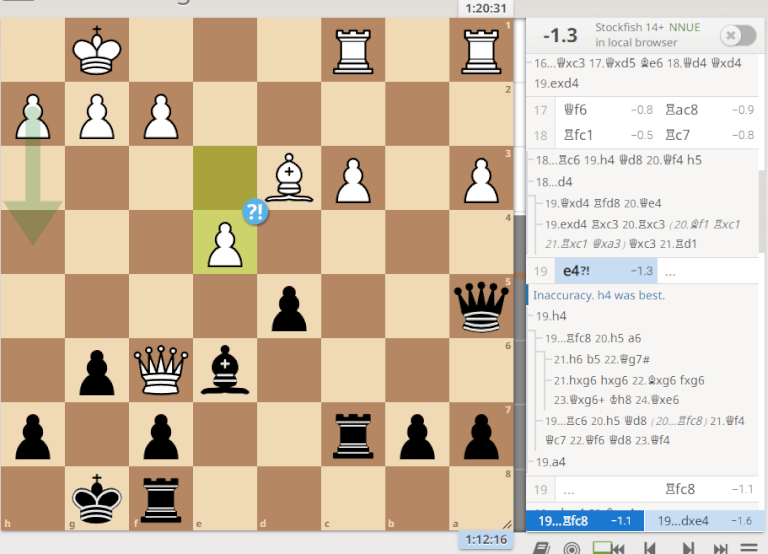
After being utterly pleased with myself, opening blunder aside, I threw the game into Chess.com’s analysis. That engine was not as enthused with my play as Lichess, thinking that I had made two inaccuracies, two mistakes, and a blunder, as opposed to Lichess’ one single mistake.
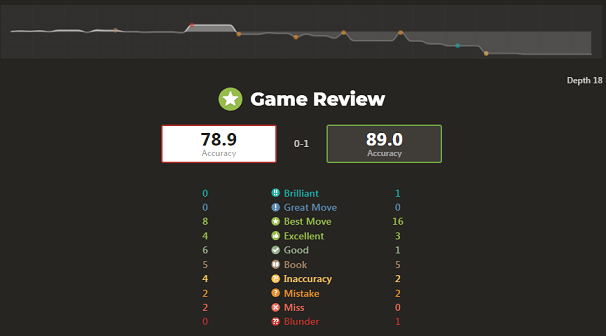
The first mistake they have me making is not playing the ridiculous move seen below. I don’t consider this to be a miss, because working through all the tactics is just too much. I can’t be blamed for not playing a move that appears to drop a pawn that can be captured in three different ways. This is especially true when doubling the rooks is only somewhat worse, and much more natural. Even after seeing that it’s the best move I still don’t think it’s the best move, if you know what I mean.

Sorry that the board is flipped. Also, d4 should get an !
The second mistake is also quite subtle. I was supposed to play b5 on move 21 instead of just taking the free pawn. This is apparently two full pawns better than what I played, for reasons that escape me. According to Chess.com, by not playing this I have blundered my advantage. I guess this must be that I can play b4 faster? I worked through the lines with the engine, and it’s still not at all clear why this is so bad.

Anyway, Chess.com does tell me that I played this game at a master level, which is very much appreciated.

And what do they think of Qd2? They give it not one, but two exclamation marks.

I can’t get over what a sexy move this was. And again, it’s not just about threatening mate, it’s about taking the counterplay out of his position by forcing the queen retreat. And the line that I play after he plays Qf3? About as sexy as the prom queen telling you her parents aren’t home. Absolutely stunning.

Again, sorry that the board keeps flipping.
The good guy is now at 3-0 in the tournament. Yes, I blundered away this game in the opening, but after that I am extremely pleased with my play, and especially that move. Let’s hope this level of play continues into the last two rounds, with greater focus and more time usage in the opening so that the games aren’t over before they even begin.















Smart guys (or just smarty pants guys) who play chess are often interested in actual history, the stuff not found in jewspapers or textbooks from shlomo – so’s here ya go on a quick interesteenk episode in some Asian History:
https://www.realhistorychan.com/chiang.html